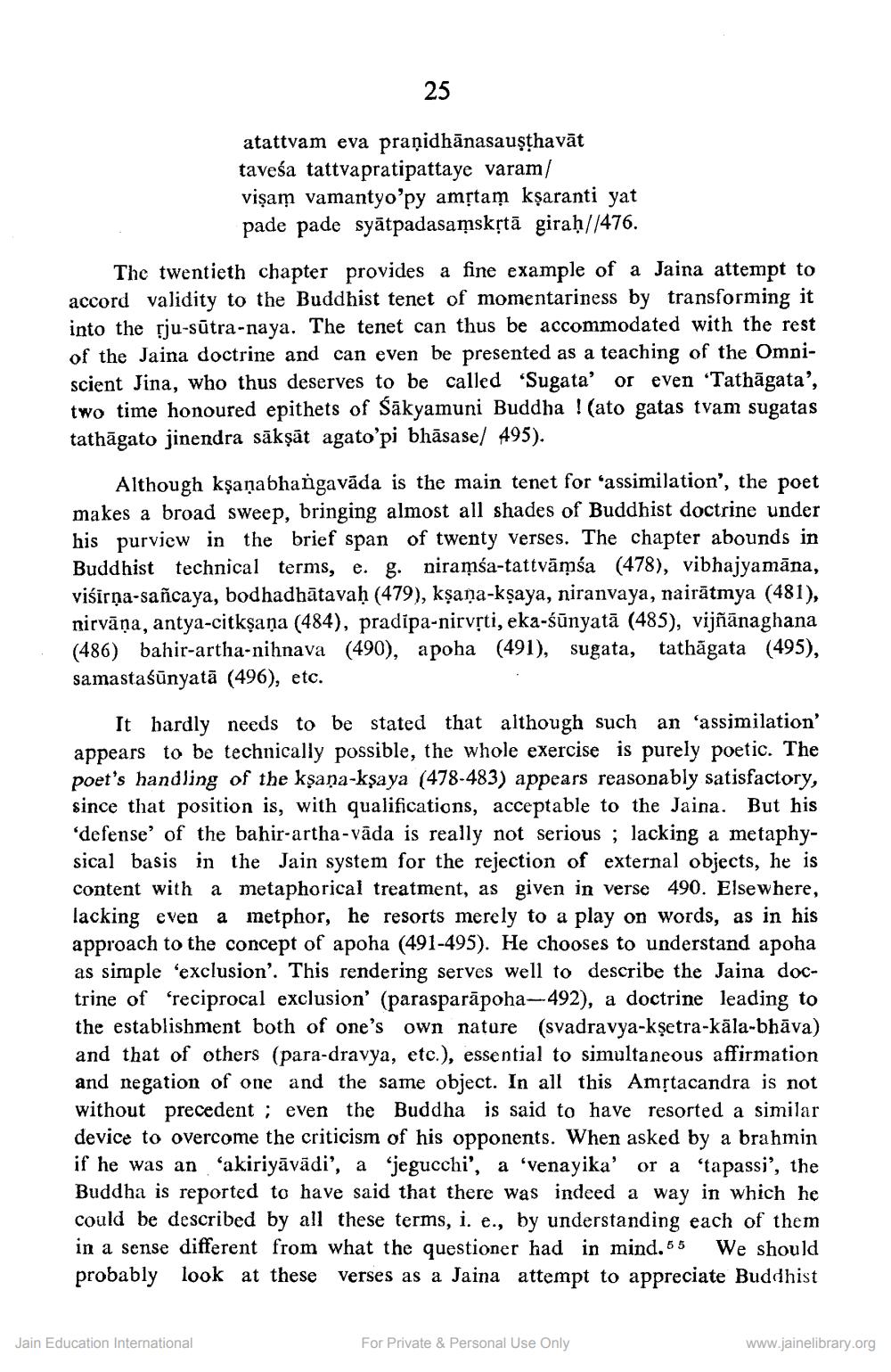________________
25
atattvam eva prasidhānasauşthavāt taveśa tattvapratipattaye varam/ visam vamantyo'py amstam kşaranti yat pade pade syātpadasaņskstā giraḥ//476.
The twentieth chapter provides a fine example of a Jaina attempt to accord validity to the Buddhist tenet of momentariness by transforming it into the įju-sūtra-naya. The tenet can thus be accommodated with the rest of the Jaina doctrine and can even be presented as a teaching of the Omniscient Jina, who thus deserves to be called "Sugata' or even "Tathāgata', two time honoured epithets of Sākyamuni Buddha ! (ato gatas tvam sugatas tathāgato jinendra sākşāt agato'pi bhāsasel 495).
Although kṣaṇabhangavāda is the main tenet for 'assimilation', the poet makes a broad sweep, bringing almost all shades of Buddhist doctrine under his purview in the brief span of twenty verses. The chapter abounds in Buddhist technical terms, e. g. niramsa-tattvāmía (478), vibhajyamāna, visirņa-sañcaya, bodhadhātavaḥ (479), kşana-kşaya, niranvaya, nairātmya (481), nirvāņa, antya-citkşaņa (484), pradipa-nirvști, eka-śūnyatā (485), vijñānaghana (486) bahir-artha-nihnava (490), apoha (491), sugata, tathāgata (495), samastaśūnyatā (496), etc.
It hardly needs to be stated that although such an 'assimilation' appears to be technically possible, the whole exercise is purely poetic. The poet's handling of the kşaņa-kşaya (478-483) appears reasonably satisfactory, since that position is, with qualifications, acceptable to the Jaina. But his defense of the bahir-artha-vāda is really not serious ; lacking a metaphysical basis in the Jain system for the rejection of external objects, he is content with a metaphorical treatment, as given in verse 490. Elsewhere, lacking even a metphor, he resorts merely to a play on words, as in his approach to the concept of apoha (491-495). He chooses to understand apoha as simple 'exclusion'. This rendering serves well to describe the Jaina doctrine of “reciprocal exclusion' (parasparāpoha-492), a doctrine leading to the establishment both of one's own nature (svadravya-kşetra-kāla-bhāva) and that of others (para-dravya, etc.), essential to simultaneous affirmation and negation of one and the same object. In all this Amstacandra is not without precedent ; even the Buddha is said to have resorted a similar device to overcome the criticism of his opponents. When asked by a brahmin if he was an 'akiriyāvādi', a "jegucchi', a 'venayika' or a 'tapassi', the Buddha is reported to have said that there was indeed a way in which he could be described by all these terms, i. e., by understanding each of them in a sense different from what the questioner had in mind.65 We should probably look at these verses as a Jaina attempt to appreciate Buddhist
Jain Education International
For Private & Personal Use Only
www.jainelibrary.org




